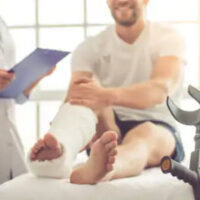Understanding Broken Bones

When people are in an accident, they often characterize their injuries as being something that has “broken.” For example, they may say “I broke my back” or “I broke my arm.” What they are really talking about is a break or fracture of a bone. And while breaking a bone may seem like a relatively straightforward and obvious injury, there are a number of important things that accident victims should understand about sustaining broken bones.
Getting Treatment
Whenever there is a broken bone or a suspected break, immediate medical care is necessary. This usually won’t be a problem, because broken bones are often painful, and the victim will usually voluntarily get medical treatment.
The good thing about broken bones is that they will often show up on the standard X-Rays that are taken in emergency rooms, which means they are often diagnosed quickly, and immediate medical attention is usually given.
Types of Fractures and Breaks
Not all bones break in the same way. There are a number of different kinds of breaks, which vary in severity.
Partial Fracture – This is the fracture that you probably picture in your mind when you think of a broken bone. A partial fracture is simply a small “crack” that develops in the bone, but which does not go all the way through the bone. Imagine bending a small rod of wood only slightly, but stopping just as the wood starts to come apart.
Complete Fracture – A complete fracture is where the crack in the bone has gone all the way through the bone. The bone has essentially been dissected into two separate parts because of the fracture.
Non-Displaced Fracture – If the bone is broken into two separate parts, the two parts may still be aligned with each other. This kind of fracture usually will not require surgery, as all the bone needs to do is heal itself in exactly the position that it is currently resting.
Displaced Fracture – This is a very serious fracture where the bone has not only been separated, but the two parts of the bone no longer “line up” the way they are supposed to. Surgery may be required to place the bones in the correct position, so that they can heal together in the right way. The area of the break may have to be immobilized.
Even More Serious Fractures
In extraordinarily serious accidents, parts of the broken bone may jut out, piercing the skin. This is obviously a displaced fracture, but is also known as an open or compound fracture. Because the bone has gone all the way outside the body, it likely has also damaged tissue or muscle.
Comminuted fractures involve a total crushing of the bone, and the bone may be in multiple, small pieces. The break is not a “clean” one, and surgery will likely be needed.
Understanding your injuries is an important part of your personal injury case. The Tampa personal injury attorneys at Barbas, Nuñez, Sanders, Butler & Hovsepian can help you if you are injured in an accident. Call us today to discuss obtaining damages for your injuries. Schedule a consultation today.
Resource:
medicalnewstoday.com/articles/173312
https://www.barbaslaw.com/do-you-have-a-claim-for-negligent-security/
